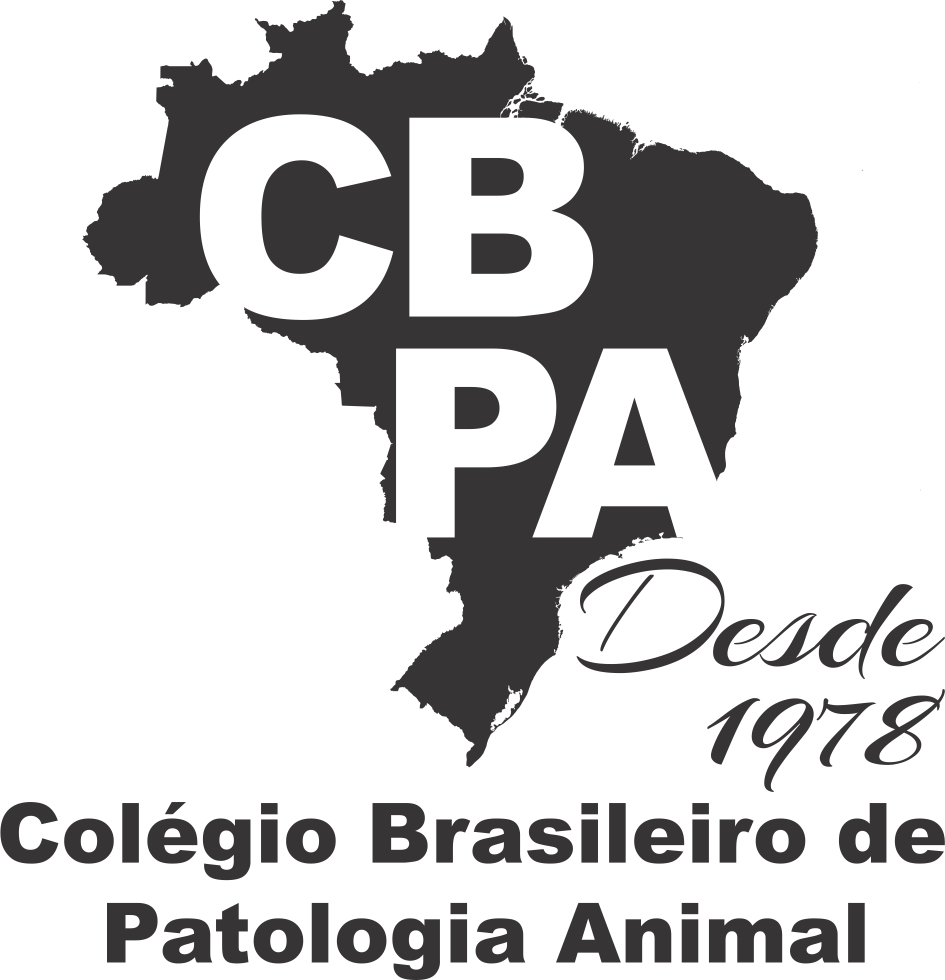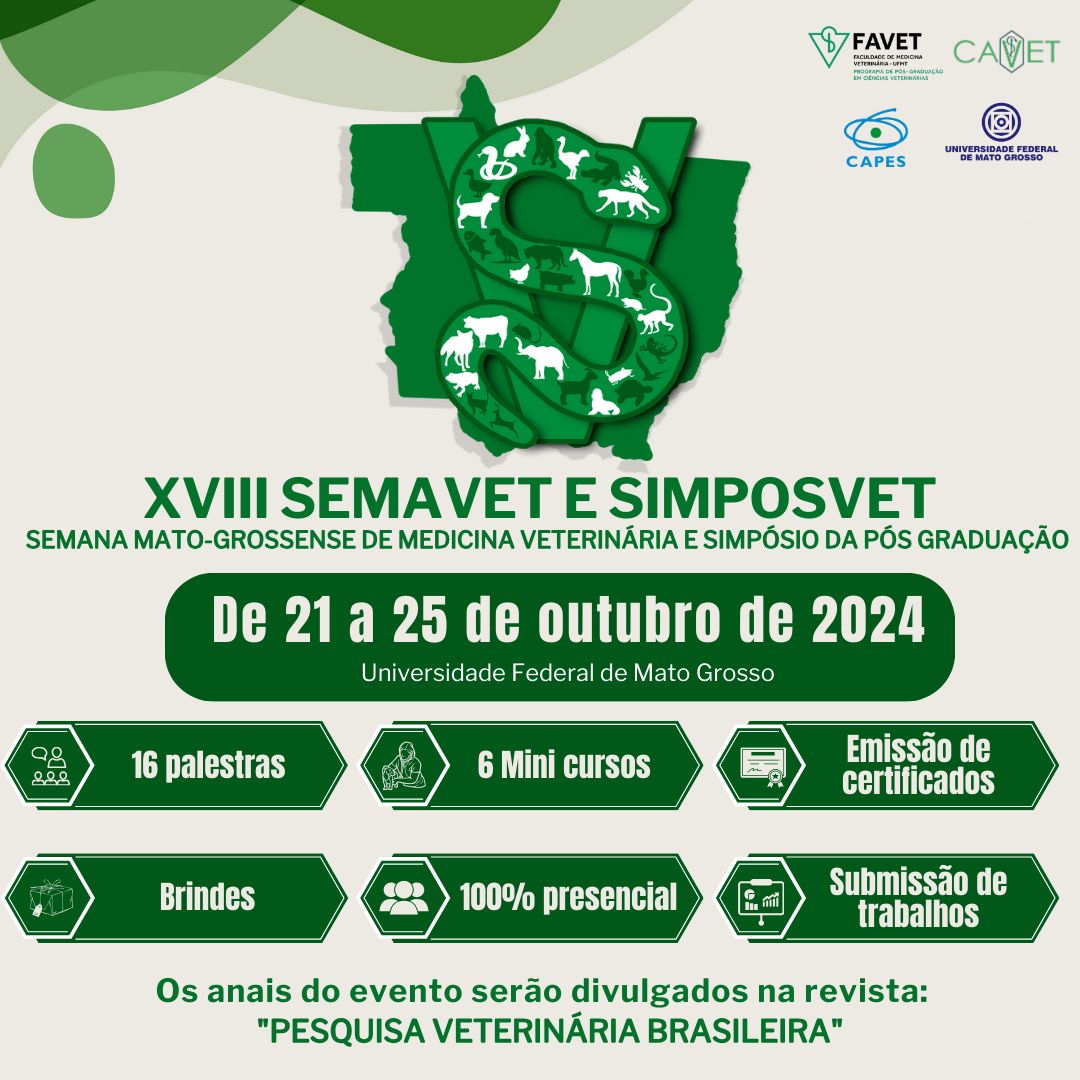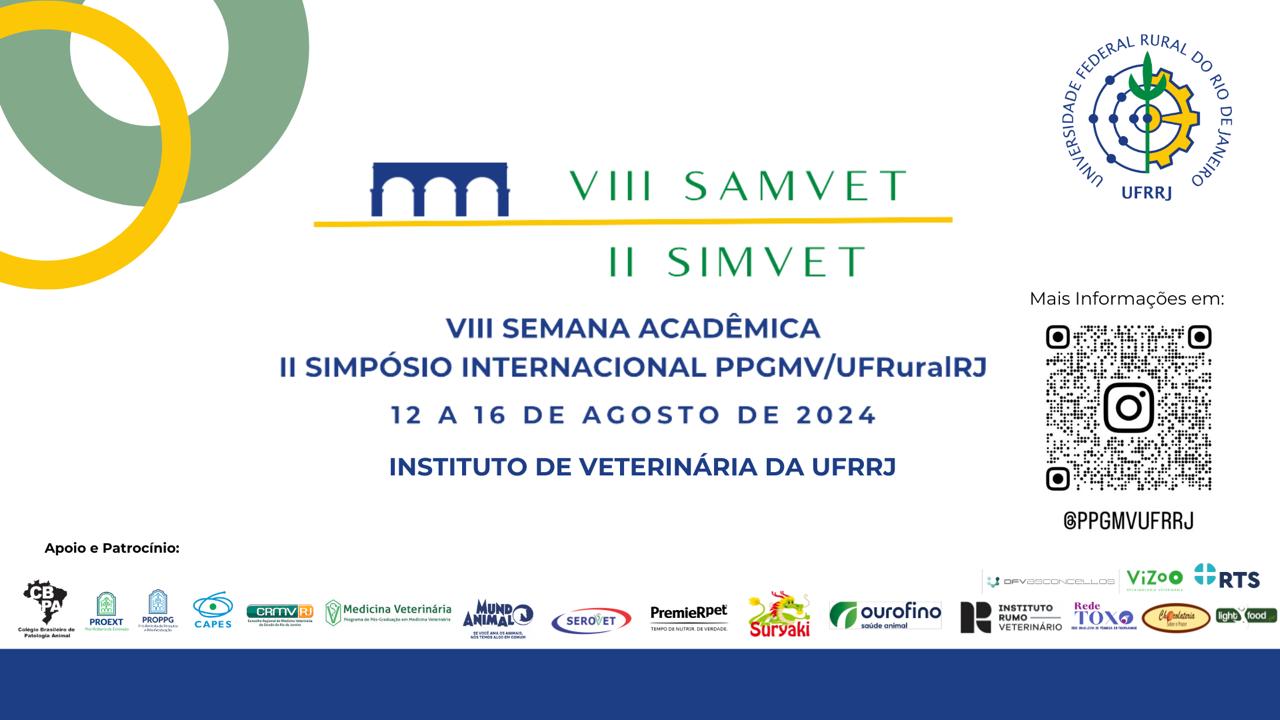Resultado da pesquisa (1435)
Termo utilizado na pesquisa 2
#1071 - Genital immunization of heifers with a glycoprotein E-deleted, recombinant bovine herpesvirus 1 strain confers protection upon challenge with a virulent isolate, 30(1):42-50
Abstract in English:
ABSTRACT.- Weiss M., Vogel F.S.F., Martins M., Weiblen R., Roehe P.M., Franco A.C. & Flores E.F. 2010. Genital immunization of heifers with a glycoprotein E-deleted, recombinant bovine herpesvirus 1 strain confers protection upon challenge with a virulent isolate. Pesquisa Veterinária Brasileira 30(1):42-50. Departamento de Medicina Veterinária Preventiva, Universidade Federal de Santa Maria, 97105-900 Santa Maria, RS, Brazil. E-mail: eduardofurtadoflores@gmail.com
Venereal infection of seronegative heifers and cows with bovine herpesvirus type 1.2 (BoHV-1.2) frequently results in vulvovaginitis and transient infertility. Parenteral immunization with inactivated or modified live BoHV-1 vaccines often fails in conferring protection upon genital challenge. We herein report an evaluation of the immune response and protection conferred by genital vaccination of heifers with a glycoprotein E-deleted recombinant virus (SV265gE-). A group of six seronegative heifers was vaccinated with SV265gE- (0,2mL containing 106.9TCID50) in the vulva submucosa (group IV); four heifers were vaccinated intramuscularly (group IM, 1mL containing 107.6TCID50) and four heifers remained as non-vaccinated controls. Heifers vaccinated IV developed mild, transient local edema and hyperemia and shed low amounts of virus for a few days after vaccination, yet a sentinel heifer maintained in close contact did not seroconvert. Attempts to reactivate the vaccine virus in two IV vaccinated heifers by intravenous administration of dexamethasone (0.5mg/kg) at day 70 pv failed since no virus shedding, recrudescence of genital signs or seroconversion were observed. At day 70 pv, all vaccinated and control heifers were challenged by genital inoculation of a highly virulent BoHV-1.2 isolate (SV-56/90, 107.1TCID50/animal). After challenge, virus shedding was detected in genital secretions of control animals for 8.2 days (8-9); in the IM group for 6.2 days (4-8 days) and during 5.2 days (5-6 days) in the IV group. Control non-vaccinated heifers developed moderate (2/4) or severe (2/4) vulvovaginitis lasting 9 to 13 days (x: 10.7 days). The disease was characterized by vulvar edema, vulvo-vestibular congestion, vesicles progressing to coalescence and erosions, fibrino-necrotic plaques and fibrinopurulent exudate. IM vaccinated heifers developed mild (1/3) or moderate (3/4) genital lesions, lasting 10 to 12 days (x: 10.7 days); and IV vaccinated heifers developed mild and transient vulvovaginitis (3/4) or mild to moderate genital lesions (1/4). In the IV group, the clinical signs lasted 4 to 8 days (x: 5.5 days). Clinical examination of the animals after challenge revealed that vaccination by both routes conferred some degree of protection, yet IV vaccination was clearly more effective in reducing the severity and duration of clinical disease. Furthermore, IV vaccination reduced the period of virus shedding in comparison with both groups. Taken together, these results demonstrate that SV265gE- is sufficiently attenuated upon IV vaccination in a low-titer dosis, is not readily reactivated after corticosteroid treatment and lastly, and more importantly, confers local protection upon challenge with a high titer of a virulent heterologous BoHV-1 isolate. Therefore, the use of this recombinant for genital immunization may be considered for prevention of BoHV-1-associated genital disease in the field.
Abstract in Portuguese:
RESUMO.- Weiss M., Vogel F.S.F., Martins M., Weiblen R., Roehe P.M., Franco A.C. & Flores E.F. 2010. Genital immunization of heifers with a glycoprotein E-deleted, recombinant bovine herpesvirus 1 strain confers protection upon challenge with a virulent isolate. [Imunização genital de bezerras com uma cepa recombinante do herpesvírus bovino tipo 1 defectiva na glicoproteína E confere proteção frente a desafio com um isolado virulento.] Pesquisa Veterinária Brasileira 30(1):42-50. Departamento de Medicina Veterinária Preventiva, Universidade Federal de Santa Maria, 97105-900 Santa Maria, RS, Brazil. E-mail: eduardofurtadoflores@gmail.com
A infecção genital de novilhas ou vacas soronegativas pelo herpesvírus bovino tipo 1.2 (BoHV-1.2) pode resultar em vulvovaginite e infertilidade temporária. As vacinas atenuadas ou inativadas administradas pela via parenteral freqüentemente conferem proteção incompleta frente a desafio pela via genital. Este estudo relata uma avaliação da resposta imunológica e proteção conferida pela vacinação genital de bezerras soronegativas com uma cepa recombinante do BoHV-1 defectiva na glicoproteína E (SV265gE-). Um grupo de seis bezerras foi vacinado com a cepa SV265gE- (0,2mL contendo 106,9TCID50) na submucosa da vulva (grupo IV); quatro bezerras foram vacinadas pela via intramuscular (IM; dose 107,6TCID50) e quatro bezerras permaneceram como controles não-vacinadas. As bezerras vacinadas pela via IV apresentaram edema e hiperemia leve e transitório na vulva e excretaram vírus em títulos baixos por alguns dias após a vacinação, porém uma bezerra soronegativa mantida em contato não soroconverteu. Administração de dexametasona pela via intravenosa no dia 70pv (0,5mg/kg) em duas bezerras vacinadas pela via IV não resultou em excreção viral, recrudescência clínica ou soroconversão. No dia 70pv, as bezerras vacinadas e as controle foram desafiadas pela inoculação genital da cepa de BoHV-1.2 altamente virulenta SV-56/90 (107.1TCID50/animal). Após o desafio, excreção viral nas secreções genitais das bezerras controle foi detectada por 8,2 dias (8-9); no grupo IM durante 6,2 dias (4-8 dias) e durante 5,2 dias (5-6) nas bezerras do grupo IN. As bezerras do grupo controle desenvolveram vulvo-vaginite moderada (2/4) a severa (2/4) que duraram entre 9 e 13 dias (x: 10,7 dias). A doença se caracterizou por edema vulvar, congestão vulvo-vestibular, formação de vesículas/pústulas que coalesceram, erosões, placas fibrino-necróticas e exsudato fibrino-purulento. As bezerras do grupo IM desenvolveram lesões genitais leves (1/3) a moderadas (3/4), com duração de 10 a 12 dias (x: 10,7 dias). No grupo IV, as bezerras desenvolveram vulvovaginite leve e transitória (3/4) ou lesões moderadas (1/4), com duração de 4 a 8 dias (x: 5,5 dias). O exame clínico desses animais após o desafio demonstrou que a vacinação, independentemente da via de administração, conferiu proteção e que, a vacinação IV mostrou-se mais efetiva na redução da severidade e duração da doença clínica. A vacinação IV também determinou uma redução significativa no período de excreção viral após desafio, em comparação com os grupos controle e IM. Esses resultados demonstram que a cepa SV265gE- administrada pela via IV confere proteção satisfatória frente a desafio local com um isolado heterólogo de BoHV-1 altamente virulento. Além disso, a cepa vacinal é atenuada para vacinação IV em baixos títulos e não é reativada facilmente após administração de dexametasona. Assim, a utilização da cepa recombinante para imunização genital pode se constituir em alternativa para prevenir a infecção e doença reprodutiva associada com o BoHV-1.
#1072 - Immunogenicity of an inactivated bovine herpesvirus type 5 strain defective in thymidine kinase and glycoprotein E, 30(1):57-62
Abstract in English:
ABSTRACT.- Brum M.C.S., Caron L., Chowdhury S.I., Weiblen R. & Flores E.F. 2010. Immunogenicity of an inactivated bovine herpesvirus type 5 strain defective in thymidine kinase and glycoprotein E. Pesquisa Veterinária Brasileira 30(1):57-62. Setor de Virologia, Departamento de Medicina Veterinária Preventiva, Centro de Ciências Rurais, Universidade Federal de Santa Maria, Av. Roraima 1000, Camobi, Santa Maria, RS 97105-900, Brazil. E-mail: eduardofurtadoflores@gmail.com
The immunogenicity of an inactivated, experimental vaccine based on a bovine herpesvirus type 5 strain defective in thymidine kinase and glycoprotein E (BoHV-5 gE/TKD) was evaluated in cattle and the results were compared with a vaccine containing the parental BoHV-5 strain (SV507/99). To formulate the vaccines, each virus (wildtype SV507/99 and BoHV-5 gE/TKD) was multiplied in cell culture and inactivated with binary ethyleneimine (BEI). Each vaccine dose contained approximately of 107.5 TCID50 of inactivated virus mixed with an oil-based adjuvant (46:54). Forty calves, 6 to 9-months-old, were allocated into two groups of 20 animals each and vaccinated twice (days 0 and 22pv) by the subcutaneous route with either vaccine. Serum samples collected at day 0 and at different intervals after vaccination were tested for virus neutralizing (VN) antibodies against the parental virus and against heterologous BoHV-5 and BoHV-1 isolates. The VN assays demonstrated seroconversion to the respective homologous viruses in all vaccinated animals after the second vaccine dose (mean titers of 17.5 for the wildtype vaccine; 24.1 for the recombinant virus). All animals remained reagents up to day 116 pv, yet showing a gradual reduction in VN titers. Animals from both vaccine groups reacted in similar VN titers to different BoHV-1 and BoHV-5 isolates, yet the magnitude of serological response of both groups was higher against BoHV-5 field isolates. Calves vaccinated with the recombinant virus did not develop antibodies to gE as verified by negative results in a gE-specific ELISA, what would allow serological differentiation from naturally infected animals. Taken together, these results indicate that inactivated antigens of BoHV-5 gE/TK recombinant virus induced an adequate serological response against BoHV-5 and BoHV-1 and thus can be used as an alternative, differential vaccine candidate.
Abstract in Portuguese:
RESUMO.- Brum M.C.S., Caron L., Chowdhury S.I., Weiblen R. & Flores E.F. 2010. Immunogenicity of an inactivated bovine herpesvirus type 5 strain defective in thymidine kinase and glycoprotein E. [Imunogenicidade de uma cepa inativada do herpesvírus bovino tipo 5 defectiva na timidina quinase e glicoproteína E.] Pesquisa Veterinária Brasileira 30(1):57-62. Setor de Virologia, Departamento de Medicina Veterinária Preventiva, Centro de Ciências Rurais, Universidade Federal de Santa Maria, Av. Roraima 1000, Camobi, Santa Maria, RS 97105-900, Brazil. E-mail: eduardofurtadoflores@gmail.com
A imunogenicidade de vacina experimental inativada, produzida com uma cepa do herpesvírus bovino tipo 5 defectiva nos genes da timidina quinase e glicoproteína E (BoHV-5 gE/TKD) foi avaliada em bovinos e o resultado foi comparado com a resposta induzida pela cepa parental do BoHV-5 (SV507/99). Para a formulação da vacina, cultivos de células infectados com cada um dos vírus (SV507/99 ou BoHV-5 gE/TKD) foram inativados com etilenamina binária. Cada dose de vacina continha aproximadamente 107,5 TCID50 de um dos vírus inativados emulsionado em adjuvante oleoso (46:54). Quarenta bezerros de raças cruzadas, com idade entre seis a nove meses, foram alocados em dois grupos de 20 animais cada e vacinados duas vezes (dia 0 e 22 pv) pela via subcutânea com uma das vacinas. Amostras de soro foram coletadas no dia 0 e a vários intervalos após vacinação para a pesquisa de anticorpos neutralizantes frente ao vírus homólogo ou frente a isolados de BoHV-5 e BoHV-1. Os testes de soroneutralização (SN) demonstraram que todos os animais soroconverteram após a segunda dose da vacina (títulos médios de 17,5 para o grupo SV507/99; 24,1 para o grupo BoHV-5 gE/TKD). Todos os animais mantiveram níveis de anticorpos neutralizantes até o dia 116 pv, no entanto foi observada uma redução gradual no títulos. A sorologia cruzada com amostras heterólogas do BoHV-5 e BoHV-1 indicou que ambos os grupos vacinais reagiram em níveis similares frente ao mesmo vírus, no entanto a magnitude da resposta sorológica foi maior frente a amostras de BoHV-5. Os animais vacinados com a cepa recombinante não desenvolveram anticorpos contra a gE detectáveis por um ELISA específico, o que permitiria a sua diferenciação sorológica de animais infectados naturalmente. Esses resultados demonstram que a vacina contendo antígenos inativados do vírus recombinante BoHV-5 gE/TKD induziu resposta sorológica em níveis satisfatórios, constituindo-se, assim, em alternativa a cepa vacinal diferencial.
#1073 - Paratuberculosis in goats and sheep in Brazil, 30(1):67-72
Abstract in English:
ABSTRACT.- Oliveira D.M., Riet-Correa F., Galiza G.J.N., Assis A.C.O., Dantas A.F.M., Bandarra P.M. & Garino Jr F. 2010. [Paratuberculosis in goats and sheep in Brazil.] Paratuberculose em caprinos e ovinos no Brasil. Pesquisa Veterinária Brasileira 30(1):67-72. Hospital Veterinário, Centro de Saúde e Tecnologia Rural, Campus de Patos, Universidade Federal de Campina Grande, Patos, PB 58700-000, Brazil. E-mail: franklin.riet@pq.cnpq.br
This paper reports paratuberculosis in sheep and goats for the first time in Brazil. On Farm 1 in a flock of 33 goats and 13 sheep, one adult female goat presented progressive weight loss during about one year, and soft feces during one month before death. All the animals from the flock were submitted to the comparative tuberculin test. One sheep was positive to the avian tuberculin (2.2%) and in two the results were inconclusive. On Farm 2, in a flock of 200 sheep and 80 goats, one adult ewe presented progressive weight loss during about one year, and soft feces during 20 days before death. All sheep older than four months of age and 23 goats were submitted to tuberculin test with avian tuberculin; 47 (25.4%) sheep were positive, 115 (61.5%) had inconclusive results, and 25 (13.4%) were negative. No positive tuberculin test were observed in the goats, but in 11 (47.8%) the test was inconclusive and in 12 (52.2%) was negative. At necropsy both affected animals had enlarged mesenteric lymph nodes. In the affected sheep, the gut wall was thickened and corrugated, mainly in the ileum and ileocecal valve. Histologically, granulomas with mainly foamy macrophages were observed in the lamina propria and submucosa of the gut, in mesenteric lymph nodes, and in the goat also in the liver. One tuberculin positive sheep and one tuberculin negative goat from Farm 1 were euthanized and necropsied. A mild thickened of the intestinal wall was observed grossly in both animals. Inflammatory infiltrate with mainly lymphocytes was observed on the submucosa and lamina propria of the gut. In the four cases acid-alcohol positive rods, positive for Mycobacterium spp. on immunohistochemical examination were observed in macro-phages and lymphocytes. New studies are necessary to know the prevalence and economical impact of paratuberculosis in goats and sheep in Brazil, to determine control measures, and to evaluate the risk of human transmission.
Abstract in Portuguese:
RESUMO.- Oliveira D.M., Riet-Correa F., Galiza G.J.N., Assis A.C.O., Dantas A.F.M., Bandarra P.M. & Garino Jr F. 2010. [Paratuberculosis in goats and sheep in Brazil.] Paratuberculose em caprinos e ovinos no Brasil. Pesquisa Veterinária Brasileira 30(1):67-72. Hospital Veterinário, Centro de Saúde e Tecnologia Rural, Campus de Patos, Universidade Federal de Campina Grande, Patos, PB 58700-000, Brazil. E-mail: franklin.riet@pq.cnpq.br
Este trabalho relata, pela primeira vez no Brasil, no Estado da Paraíba, paratuberculose em dois rebanhos com criação conjunta de caprinos e ovinos. Na Fazenda 1, de um rebanho de 33 caprinos e 13 ovinos, uma cabra adulta apresentou emagrecimento progressivo por aproximadamente um ano e fezes pastosas um mês antes da morte. Todos os animais do rebanho foram tuberculinizados com a prova comparativa. Um ovino (2,2%) teve resultado positivo à tuberculina aviar e em dois o teste foi inconclusivo. Na Fazenda 2, com 200 ovinos e 80 caprinos, foi afetada uma ovelha adulta que apresentou emagrecimento progressivo por aproximadamente um ano e fezes pastosas por aproximadamente 20 dias. Todos os ovinos com mais de 4 meses de idade e 23 caprinos foram tuberculinizados com tuberculina aviar; em 47 (25,4%) o resultado foi positivo, em 115 (61,5%) inconclusivo e em 25 (13,4%) negativo. Entre as cabras não houve nenhuma positiva à tuberculina aviar, mas em 11 (47,8%) o teste foi inconclusivo e em 12 (52,2%) foi negativo. Na necropsia dos dois animais com sinais clínicos os linfonodos mesentéricos estavam aumentados de tamanho e edemaciados. O ovino afetado da Fazenda 2, apresentou espessamento e enrugamento da mucosa do intestino, principalmente no íleo e válvula íleo-cecal. Microscopicamente o caprino e o ovino com sinais clínicos apresentaram lesões semelhantes, caracterizadas por granulomas com predominância de macrófagos espumosos, na lâmina própria e submucosa do intestino e linfonodos mesentéricos. O ovino positivo à tuberculina e um caprino negativo na Fazenda 1 foram eutanasiados e apresentaram discreto espessamento da mucosa do íleo. Na histologia foi observado infiltrado preferentemente linfocítico. Em todos os casos dentro de macrófagos e linfócitos havia bacilos ácool-ácidos resistentes, positivos na imuno-histoquímica para Mycobacterium spp. Sugere-se a necessidade de estudar a prevalência de paratuberculose em rebanhos de caprinos e ovinos no Brasil, determinar medidas de controle e avaliar a possibilidade de transmissão para humanos.
#1074 - Occurrence of parasitism by Dioctophyma renale in ring-tailed coatis (Nasua nasua) of the Tiete Ecological Park, São Paulo, Brazil, 29(12):959-962
Abstract in English:
ABSTRACT.- Milanelo L., Moreira M.B., Fitorra L.S., Petri B.S.S., Alves M. & Santos A.C. 2009. Occurrence of parasitism by Dioctophyma renale in ring-tailed coatis (Nasua nasua) of the Tiete Ecological Park, São Paulo, Brazil. Pesquisa Veterinária Brasileira 29(12):959-962. Centro de Recuperação de Animais Selvagens, Parque Ecológico do Tietê, Departamento de Águas e Energia Elétrica, Rua Guira Acangatara 70, Engenheiro Goulart, São Paulo, SP 03719-000, Brazil. E-mail: lmilanelo@gmail.com
Dioctophymosis is a worldwide renal parasitosis caused by the Dioctophyma renale nematode, which results in progressive destruction of renal tissue. Aquatics annelids are considered the main intermediate hosts and the literature refers as permanent hosts of dogs, wild mammals and even humans. During procedures for population control of coatis (Nasua nasua) in the Ecological Park of Tietê (PET), was noticed the presence of parasitosis by D. renale. From 68 animals, males and females, young and adults, submitted to exploratory laparotomy, 51 were positive for the presence of worms, 9 were found only in the right kidney. In 10 cases, in addition to right kidney parasitism, worms were also observed in the abdominal cavity. In 24 cases D. renale was found only in the abdominal cavity and in 8 animals the right kidney was reduced to a small rigid structure. The study showed that the preferred site for parasitism of the worm, considered erratic, was the abdominal cavity in 66.66% of the cases.
Abstract in Portuguese:
RESUMO.- Milanelo L., Moreira M.B., Fitorra L.S., Petri B.S.S., Alves M. & Santos A.C. 2009. Occurrence of parasitism by Dioctophyma renale in ring-tailed coatis (Nasua nasua) of the Tiete Ecological Park, São Paulo, Brazil. [Ocorrência de parasitismo por Dioctophyma renale em quati (Nasua nasua) do Parque Ecológico Tietê, São Paulo.] Pesquisa Veterinária Brasileira 29(12):959-962. Centro de Recuperação de Animais Selvagens, Parque Ecológico do Tietê, Departamento de Águas e Energia Elétrica, Rua Guira Acangatara 70, Engenheiro Goulart, São Paulo, SP 03719-000, Brazil. E-mail: lmilanelo@gmail.com
RESUMO.- [Ocorrência de parasitismo por Dioctophyma renale em quati (Nasua nasua) do Parque Ecológico Tietê, São Paulo.] A dioctofimose é uma parasitose renal causada pelo nematóide Dioctophyma renale conhecida por gerar a destruição progressiva do parênquima renal. Anelídeos de água doce são considerados os principais hospedeiros intermediários e a literatura refere como hospedeiros definitivos cães domésticos, mamíferos selvagens e até seres humanos. Durante procedimentos de controle populacional de quatis (Nasua nasua) no Parque Ecológico do Tietê (PET), evidenciou-se a presença do parasitismo por D. renale. Sessenta e oito animais foram submetidos à laparotomia, machos e fêmeas, jovens e adultos, dos quais 51 foram positivos para presença do parasita. Em 9 animais o parasita esteve presente apenas no rim direito; em 10 animais D. renale parasitava o rim direito e a cavidade abdominal simultaneamente. Em outros 24 quatis o parasita foi encontrado apenas na cavidade abdominal e em 8 animais o rim direito foi reduzido apenas a uma pequena estrutura rígida. O estudo demonstrou que para este hospedeiro (Nasua nasua), o rim direito não parece ser local de escolha do parasita, já que o encontro do verme em 66,6% dos casos foi a cavidade abdominal.
#1075 - Ultimobranchial gland of freshwater catfish, Heteropneustes fossilis, in response to calcitonin administration, 29(12):963-968
Abstract in English:
ABSTRACT.- Srivastav A.K., Singh S., Mishra D. & Srivastav S.K. 2009. Ultimobranchial gland of freshwater catfish, Heteropneustes fossilis, in response to calcitonin administration. Pesquisa Veterinária Brasileira 29(12):963-968. Department of Zoology, DDU Gorakhpur University, Gorakhpur 273 009, India. E-mail: ajaiksrivastav@hotmail.com
The absence o!!f a hypocalcemic effect of calcitonin (CT) in fishes has been suggested due to exceedingly high plasma levels of CT; the fish may be saturated with respect of circulating CT and therefore unable to respond to exogenously administered CT. Earlier it has been suggested that a hypocalcemic action of injected CT may be obscured by changes in the release of endogenous CT and other calcium regulating hormones. In this study we have used artificial freshwater, calcium-deficient freshwater and calcium-rich freshwater and injected the fish with CT. The aim behind selecting these media were (i) in calcium-deficient medium there would be reduced circulating levels of CT, (ii) in calcium-rich medium there would be diminished secretion of prolactin (this hormone is hypercalcemic in fish), and (iii) by keeping the fish in calcium-rich medium we can test the antihypercalcemic action of CT. Moreover, the present study would reveal the changes in the ultimobranchial gland (UBG) after keeping the fish in all the above three media and/or injecting the fish with CT. Freshwater catfish, Heteropneustes fossilis, were administered intraperitoneally daily with vehicle or 0.5 U/100g body wt of salmon calcitonin (CT) and kept in artificial freshwater, calcium-rich freshwater and calcium-deficient freshwater for 10 days. Blood samples were collected on 1, 3, 5, and 10 days following the treatment and analyzed for serum calcium levels. The ultimobranchial gland (UBG) was also fixed for histological studies on these intervals. In artificial freshwater there was no change in the serum calcium levels of calcitonin-injected fish. The ultimobranchial gland of calcitonin-injected fish exhibited a progressive decrease in the nuclear volume from day 5 onwards. On day 10 vacuolization in the gland was also noticed. In vehicle-injected fish (control) kept in calcium-rich freshwater hypercalcemia has been noticed which persists till the end of the experiment. In calcitonin-treated fish maintained in calcium-rich freshwater there is no change in serum calcium level as compared to vehicle-injected fish. In vehicle-injected fish the UBG depicts decreased staining response and increased nuclear volume at day 5. On day 10 the nuclear volume is further increased and few degenerating cells have been noticed. Calcitonin fails to induce any histological change in the UBG as compared to control. In vehicle-injected fish kept in calcium-deficient freshwater the serum calcium levels decrease from day 1 to day 3. The levels exhibit hypercalcemia on day 10. CT treatment to the fish kept in calcium-deficient freshwater evokes a decrease in the calcium levels on day 1 and day 3. A significant hypercalcemia has been noticed on day 5 and day 10. In vehicle-injected fish kept in calcium-deficient freshwater the UBG reveals a decreased staining response on day 10. In CT-injected fish maintained in calcium-deficient freshwater the UBG depicts an increased nuclear volume and few exhausted cells on day 10. It can be concluded that CT can provoke hypocalcemia only when the fish is kept in medium which reduces the circulating levels of this hormone. The UBG of the fish kept in different calcemic media responded in a manner to indicate that it produces hypocalcemic factor - CT.
Abstract in Portuguese:
ABSTRACT.- Srivastav A.K., Singh S., Mishra D. & Srivastav S.K. 2009. Ultimobranchial gland of freshwater catfish, Heteropneustes fossilis, in response to calcitonin administration. Pesquisa Veterinária Brasileira 29(12):963-968. Department of Zoology, DDU Gorakhpur University, Gorakhpur 273 009, India. E-mail: ajaiksrivastav@hotmail.com
The absence o!!f a hypocalcemic effect of calcitonin (CT) in fishes has been suggested due to exceedingly high plasma levels of CT; the fish may be saturated with respect of circulating CT and therefore unable to respond to exogenously administered CT. Earlier it has been suggested that a hypocalcemic action of injected CT may be obscured by changes in the release of endogenous CT and other calcium regulating hormones. In this study we have used artificial freshwater, calcium-deficient freshwater and calcium-rich freshwater and injected the fish with CT. The aim behind selecting these media were (i) in calcium-deficient medium there would be reduced circulating levels of CT, (ii) in calcium-rich medium there would be diminished secretion of prolactin (this hormone is hypercalcemic in fish), and (iii) by keeping the fish in calcium-rich medium we can test the antihypercalcemic action of CT. Moreover, the present study would reveal the changes in the ultimobranchial gland (UBG) after keeping the fish in all the above three media and/or injecting the fish with CT. Freshwater catfish, Heteropneustes fossilis, were administered intraperitoneally daily with vehicle or 0.5 U/100g body wt of salmon calcitonin (CT) and kept in artificial freshwater, calcium-rich freshwater and calcium-deficient freshwater for 10 days. Blood samples were collected on 1, 3, 5, and 10 days following the treatment and analyzed for serum calcium levels. The ultimobranchial gland (UBG) was also fixed for histological studies on these intervals. In artificial freshwater there was no change in the serum calcium levels of calcitonin-injected fish. The ultimobranchial gland of calcitonin-injected fish exhibited a progressive decrease in the nuclear volume from day 5 onwards. On day 10 vacuolization in the gland was also noticed. In vehicle-injected fish (control) kept in calcium-rich freshwater hypercalcemia has been noticed which persists till the end of the experiment. In calcitonin-treated fish maintained in calcium-rich freshwater there is no change in serum calcium level as compared to vehicle-injected fish. In vehicle-injected fish the UBG depicts decreased staining response and increased nuclear volume at day 5. On day 10 the nuclear volume is further increased and few degenerating cells have been noticed. Calcitonin fails to induce any histological change in the UBG as compared to control. In vehicle-injected fish kept in calcium-deficient freshwater the serum calcium levels decrease from day 1 to day 3. The levels exhibit hypercalcemia on day 10. CT treatment to the fish kept in calcium-deficient freshwater evokes a decrease in the calcium levels on day 1 and day 3. A significant hypercalcemia has been noticed on day 5 and day 10. In vehicle-injected fish kept in calcium-deficient freshwater the UBG reveals a decreased staining response on day 10. In CT-injected fish maintained in calcium-deficient freshwater the UBG depicts an increased nuclear volume and few exhausted cells on day 10. It can be concluded that CT can provoke hypocalcemia only when the fish is kept in medium which reduces the circulating levels of this hormone. The UBG of the fish kept in different calcemic media responded in a manner to indicate that it produces hypocalcemic factor - CT.
#1076 - Influence of body temperature on rattlesnakes (Crotalus durissus) anesthetized with ketamine, 29(12):969-973
Abstract in English:
ABSTRACT.- Carregaro A.B., Cruz M.L., Cherubini A.L. & Luna S.P.L. 2009. [Influence of body temperature on rattlesnakes (Crotalus durissus) anesthetized with ketamine.] Influência da temperatura corporal de cascavéis (Crotalus durissus) submetidas à anestesia com cetamina. Pesquisa Veterinária Brasileira 29(12):969-973. Departamento de Clínica de Pequenos Animais, Centro de Ciências Rurais, Universidade Federal de Santa Maria, 97105-900, Santa Maria, Brazil. E-mail: carregaro@smail.ufsm.br
The aim of the study was to verify the influence of the body temperature under physiological values and latency and recovery times on rattlesnakes anesthetized with ketamine. The animals were previously submitted to hypothermia (HYPO) (<22°C) and normothermia (30°C) (NORMO) and then, anesthetized with 80 mg/kg IM of ketamine. Latency and recovery times were evaluated by head tonus, muscular tonus and righting reflex. Heart rate (HR), time of apnea and body temperature were measured before and 5, 10, 15, 30, 60, 90 and 120 minutes after ketamine administration. Blood gases parameters were measured before, 30 and 60 minutes. It was not observed difference on latency time in both groups. The recovery time was higher on HYPO (5,5 hours) compared to NORMO (3,5 hours). HR was higher on NORMO compared to HYPO. Time of apnea was the same pattern on both groups. Compared to basal levels, time of apnea was shorter between 5 to 30 min on both groups. Respiratory acidosis was observed only at 0 min in NORMO. SvO2 was higher after 30 min, the same as with PvO2 in both groups. PvCO2 reduced after 30 min in both groups. It was evident that body temperature exerts intense influence on the recovery time on rattlesnakes anesthetized with ketamine.
Abstract in Portuguese:
RESUMO.- Carregaro A.B., Cruz M.L., Cherubini A.L. & Luna S.P.L. 2009. [Influence of body temperature on rattlesnakes (Crotalus durissus) anesthetized with ketamine.] Influência da temperatura corporal de cascavéis (Crotalus durissus) submetidas à anestesia com cetamina. Pesquisa Veterinária Brasileira 29(12):969-973. Departamento de Clínica de Pequenos Animais, Centro de Ciências Rurais, Universidade Federal de Santa Maria, 97105-900, Santa Maria, Brazil. E-mail: carregaro@smail.ufsm.br
O estudo objetivou verificar a influência da temperatura corporal nos parâmetros fisiológicos e nos períodos de indução e recuperação anestésicos de cascavéis (Crotalus durissus) anestesiadas com cetamina. Os animais foram previamente submetidos à hipotermia (HIPO) (<22°C) e normotermia (30°C) (NORMO) e anestesiados com 80mg/kg IM de cetamina. Foram avaliados os períodos de latência e recuperação da anestesia por meio do tônus de cabeça, tônus muscular e reflexo de endireitamento. Mensurou-se a frequência cardíaca (FC), tempo de apnéia e temperatura corporal em 0 min e 5, 10, 15, 30, 60, 90, 120 min e análise dos gases sanguíneos em 0 min, 30 e 60 min. Não houve diferença em relação ao período de latência entre os grupos. A recuperação dos animais em HIPO foi mais prolongada (5,5 horas) que em NORMO (3,5 horas). Obteve-se FC no grupo NORMO superior que no grupo HIPO. O tempo de apnéia manteve o mesmo padrão em ambos os grupos. Em relação ao basal, tanto em HIPO quanto em NORMO o tempo de apnéia diminuiu acentuadamente entre 5 e 30 min. Observou-se acidose respiratória no grupo NORMO apenas em 0 min. O SvO2 elevou-se significativamente após 30 min, o mesmo ocorrendo com a PvO2. A PvCO2 diminuiu em ambos os grupos após 30 min. Evidenciou-se que a temperatura corporal influencia intrinsecamente o período de recuperação de cascavéis anestesiadas com cetamina.
#1077 - Hematological profile of Chelonia mydas (Testudines, Cheloniidae) according to the severity of fibropapillomatosis or its absence, 29(12):974-978
Abstract in English:
ABSTRACT.- Rossi S., Zwarg T., Sanches T.C., César M.O., Werneck M.R. & Matushima E.R. 2009. Hematological profile of Chelonia mydas (Testudines, Cheloniidae) according to the severity of fibropapillomatosis or its absence. Pesquisa Veterinária Brasileira 29(12):974-978. Depto Patologia, Faculdade de Medicina Veterinária e Zootecnia, Universidade de São Paulo, Av. Prof. Dr. Orlando Marques de Paiva 87, Cidade Universitária, São Paulo, SP 05508-900, Brazil. E-mail: rossi.silmara@yahoo.com.br
The green turtle Chelonia mydas feeds and nests in the Brazilian coastal area and is considered an endangered species by the World Conservation Union (IUCN 2009) and threatened by the Red List of Brazilian Fauna (Ministério do Meio Ambiente 2009). Fibropapillomatosis is a disease characterized by benign skin tumors (fibropapillomas), and it is one of the main threats to the survival of this species. Studies suggest the involvement of viruses as infectious agents associated with environmental and genetic factors. Blood samples were collected from 45 turtles captured in the coastal area of the state of Sao Paulo, Brazil. From these, 27 were affected by fibropapillomas and 18 were tumor free. Biometrical data on the turtles, size, location and quantity of tumors were recorded. The area occupied by fibropapillomas per animal was calculated and four groups were determined according to severity of the disease or its absence. The objective of the study was to compare hemogram results of the sea turtles classified in these four groups. The lowest hematocrit value was observed in severely affected animals. In the hemoglobin assay, the highest value was observed in the group of tumor free turtles and the lowest, in animals severely affected. Lymphocyte counts and curved carapace length were on the verge of statistical significance.
Abstract in Portuguese:
RESUMO.- Rossi S., Zwarg T., Sanches T.C., César M.O., Werneck M.R. & Matushima E.R. 2009. Hematological profile of Chelonia mydas (Testudines, Cheloniidae) according to the severity of fibropapillomatosis or its absence. [Perfil hematológico de Chelonia mydas (Testudines, Cheloniidae) de acordo com o grau de acometimento pela fibropapilomatose e sua ausência.] Pesquisa Veterinária Brasileira 29(12):974-978. Depto Patologia, Faculdade de Medicina Veterinária e Zootecnia, Universidade de São Paulo, Av. Prof. Dr. Orlando Marques de Paiva 87, Cidade Universitária, São Paulo, SP 05508-900, Brazil. E-mail: rossi.silmara@yahoo.com.br
Chelonia mydas, denominada tartaruga verde, é uma tartaruga marinha que frequenta o litoral brasileiro para alimentação e nidificação e é considerada em perigo de extinção pela IUCN (World Conservation Union, 2009) e ameaçada pela Lista Vermelha da Fauna Brasileira (Ministério do Meio Ambiente, 2009). A fibropapilomatose, doença caracterizada por tumores cutâneos benignos (fibropapilomas), é uma das mais importantes ameaças à sobrevivência dessa espécie. Pesquisas sugerem o envolvimento de agentes infecciosos virais em associação com fatores ambientais e genéticos. Foram colhidas amostras sanguíneas de 45 tartarugas provenientes do litoral do estado de São Paulo, Brasil, sendo 18 sem fibropapilomas e 27 acometidas. Dados de biometria das tartarugas, quantidade, localização e tamanho dos tumores foram anotados. Foi realizado o cálculo da área de fibropapilomas por animal e foram estipulados 4 grupos de acordo com o grau de acometimento e sua ausência. O objetivo foi realizar uma comparação entre os hemogramas das tartarugas marinhas classificadas nos 4 grupos. Animais de grau grave apresentaram o menor valor para hematócrito. Para dosagem de hemoglobina, observou-se que o maior valor foi para o grupo de tartarugas sem fibropapilomas e o menor para o de grau grave. Os valores de linfócitos e comprimento curvilíneo da carapaça beiraram a significância estatística.
#1078 - Retrospective study of ocular disorders in Amazon parrots, 29(12):979-984
Abstract in English:
ABSTRACT.- Hvenegaard A.P., Safatle A.M.V, Guimarães M.B. & Barros P.S.M. 2009. Retrospective study of ocular disorders in Amazon parrots. Pesquisa Veterinária Brasileira 29(12):979-984. Serviço de Oftalmologia do Hospital Veterinário, Faculdade de Medicina Veterinária e Zootecnia, Universidade de São Paulo, Avenida Prof. Dr. Orlando Marques de Paiva 87, Cidade Universitária, São Paulo, SP 05508 270, Brazil. E-mail: ana6113@hotmail.com
A retrospective study was conducted to identify the occurrence and types of ocular disorders in 57 Amazon parrots admitted to the Ophthalmology Service, Veterinary Teaching Hospital, School of Veterinary Medicine, University of São Paulo, Brazil from 1997 to 2006. The most frequent observed disorder was cataracts, present in 24 of the 114 examined eyes (57 parrots). Uveitis, ulcerative keratitis and keratoconjunctivitis were frequently diagnosed as well. The cornea was the most affected ocular structure, with 28 reported disorders. Uveal disorders also were commonly observed. Conjunctiva and eyelid disorders were diagnosed in lower frequency. Results suggest that cataracts are common and that cornea, lens and uvea are the most affected ocular structures in Amazon parrots.
Abstract in Portuguese:
RESUMO.- Hvenegaard A.P., Safatle A.M.V, Guimarães M.B. & Barros P.S.M. 2009. Retrospective study of ocular disorders in Amazon parrots. [Estudo retrospectivo das alterações oculares observadas em papagaios.] Pesquisa Veterinária Brasileira 29(12):979-984. Serviço de Oftalmologia do Hospital Veterinário, Faculdade de Medicina Veterinária e Zootecnia, Universidade de São Paulo, Avenida Prof. Dr. Orlando Marques de Paiva 87, Cidade Universitária, São Paulo, SP 05508 270, Brazil. E-mail: ana6113@hotmail.com
Realizou-se estudo retrospectivo para identificar a ocorrência e os tipos de alterações oculares observadas em 57 papagaios atendidos no Serviço de Oftalmologia do Hospital Veterinário da Faculdade de Medicina Veterinária e Zootecnia da Universidade de São Paulo (USP), de 1997-2006. Catarata em diferentes estágios de evolução foi a alteração ocular mais frequentemente diagnosticada, sendo observada em 24 dos 114 olhos examinados. Uveíte, ceratite ulcerativa e ceratoconjuntivite foram também diagnosticadas. A córnea foi a estrutura ocular mais acometida (28 registros). Alterações uveais foram frequentemente observadas. Alterações das pálpebras e conjuntiva foram observadas em menor freqüência. Concluí-se que catarata foi a alteração mais frequentemente observada e que a córnea, lente e úvea são as estruturas oculares mais susceptíveis a alterações em papagaios.
#1079 - Assessment of blood inflammatory response in BCG stimulated rattlesnakes (Crotalus durissus Linnaeus, 1758), 29(12):985-992
Abstract in English:
ABSTRACT.- Silva W.B., Machado C., Goldberg D.W., Moreira S.B., Silva L.C.C.P., Freire I.M.A., Maciel P.O. & Almosny N.R. 2009. [Assessment of blood inflammatory response in BCG stimulated rattlesnakes (Crotalus durissus Linnaeus, 1758).] Avaliação da resposta hematológica em cascavéis (Crotalus durissus Linnaeus, 1758) inoculadas com BCG. Pesquisa Veterinária Brasileira 29(12):985-992. Programa de Pós-Graduação em Clínica e Reprodução Animal, Faculdade de Medicina Veterinária, Universidade Federal Fluminense, Rua Vital Brazil Filho 64, Niterói, RJ 24230-360, Brazil. E-mail: wellban@yahoo.com.br
The high demand for anti-venom production in response to the increased number of cases of snakebite envenomation highlights the importance of raising and breeding venomous snakes in captivity. Knowledge of types of venoms and anti-venoms is of great interest to public health. The maintenance of venomous serpents in captivity started in the early twentieth century, but still nowadays it is a challenge to manage and prevent diseases in captive fauna. Hematology is commonly used for general health assessment and illness detection. However, data on serpent blood analysis are still scarce. Alterations in hematological parameters were experimentally induced in rattlesnakes by the inoculation of BCG. Based on this, hemograms can be used as a health auxiliary diagnosis method for bacterial diseases in this species. In this study, blood samples were taken from 10 healthy specimens of rattlesnakes (Crotalus durissus) born and bred in captivity in the Herpetological Division of Vital Brazil Institute. Animals were divided into two groups (group 1 and 2) with similar live weight and sex proportion, and were then inoculated subcutaneously with BCG (Bacillus Calmette-Guérin). Blood samples were taken before and after inoculation at three experimental times (days 3, 5 and 7 for group 1 and days 11, 17 and 21 for group 2). Hematological analysis was performed through semi-direct technique, blood samples were diluted in Natt and Herrick solution and smears were stained by Giemsa. Serpents from group 1 developed discrete anemia due to the inflammatory syndrome, and showed significant decrease of MCH and MCHC. Granulocytes were characterized by the presence of rough granules. The azurophils varied in shape and size and showed large amount of cytoplasmic vacuoles. The thrombocytopenia observed in group 2 suggests that these cells participate in the inflammatory process. A single individual from group 1 showed granulocytosis and a few animals showed a discrete azurophilia. In general, BCG inoculation unleashes hematological inflammatory responses characterized by the presence of thrombocytes, azurophils and granulocytes cells.
Abstract in Portuguese:
RESUMO.- Silva W.B., Machado C., Goldberg D.W., Moreira S.B., Silva L.C.C.P., Freire I.M.A., Maciel P.O. & Almosny N.R. 2009. [Assessment of blood inflammatory response in BCG stimulated rattlesnakes (Crotalus durissus Linnaeus, 1758).] Avaliação da resposta hematológica em cascavéis (Crotalus durissus Linnaeus, 1758) inoculadas com BCG. Pesquisa Veterinária Brasileira 29(12):985-992. Programa de Pós-Graduação em Clínica e Reprodução Animal, Faculdade de Medicina Veterinária, Universidade Federal Fluminense, Rua Vital Brazil Filho 64, Niterói, RJ 24230-360, Brazil. E-mail: wellban@yahoo.com.br
A criação de serpentes peçonhentas em cativeiro para produção de soros antipeçonhas possui crescente importância para a saúde pública devido ao aumento do número de notificações de acidentes ofídicos a cada ano no Brasil. Iniciado no século XX, ainda hoje essa atividade apresenta alguns desafios como a instalação de doenças no plantel. O hemograma é um exame de triagem clínica que auxilia no diagnóstico de diversas moléstias que acometem diferentes espécies de animais, no entanto ainda pouco estudado em serpentes. A caracterização das alterações hematológicas em cascavéis inoculadas experimentalmente com BCG pode servir de base na utilização deste exame no auxílio ao diagnóstico de infecções bacterianas na espécie. Dessa forma, foram realizados exames hematológicos em 10 serpentes da espécie Crotalus durissus pertencentes ao plantel da Divisão de Herpetologia do Instituto Vital Brazil. Os animais foram divididos em dois grupos (Grupos 1 e 2), homogêneos entre si em relação ao peso e proporção sexual. Os dois grupos foram inoculados com BCG e submetidos à coleta de sangue antes da inoculação e em três momentos pós-inoculação (3º, 5º, e 7º dias para o Grupo 1 e 11º, 17º e 21º dias para o Grupo 2). O hemograma foi realizado por método semidireto pela utilização de líquido de Natt e Herrick e as lâminas foram coradas pelo Giemsa. Observou-se anemia discreta, com redução dos valores de concentração de hemoglobina corpuscular média e da hemoglobina globular média no Grupo 1 que foi relacionada à doença inflamatória. A trombocitopenia observada no Grupo 2 sugeriu a atuação deste tipo celular em processos inflamatórios. Um único animal do Grupo 1 apresentou granulocitose e alguns animais apresentaram discreta azurofilia. Observaram-se alterações morfológicas nos leucócitos. Os granulócitos apresentaram granulações grosseiras e os azurófilos apresentaram aumento de tamanho e grandes vacúolos. De forma geral, a inoculação de BCG em cascavéis desencadeia respostas inflamatórias hematológicas caracterizadas pela participação de trombócitos, granulócitos e azurófilos.
#1080 - Reproductive characteristics of Brazilian dwarf brocket deer (Mazama nana), 29(12):993-998
Abstract in English:
ABSTRACT.- Abreu C.O., Martinez A.C., Moraes W., Juvenal J.C. & Moreira N. 2009. [Reproductive characteristics of Brazilian dwarf brocket deer (Mazama nana).] Características reprodutivas de veado-bororó-do-sul ou veado-mão-curta (Mazama nana). Pesquisa Veterinária Brasileira 29(12):993-998. Departamento de Medicina Veterinária, Universidade Estadual de Maringá, Campus Umuarama, Estrada da Paca s/n, Maringá, PR 87506-370. E-mail: cassianabreu@gmail.com
Mazama nana is the least known of Brazilian deer species. The male reproductive parameters are still unknown, but apparently they did not show reproductive seasonality. In this work were used nine males of M. nana in reproductive age, kept in captivity. They were assessed for weight, height of wither, crown-rump length, the situation of horns, testicular volume and consistency. The sperm was collected by electro-ejaculation and subjected to analyses of motility, vigor and morphology. The correlation between age, weight, height of wither, crown-rump length, testicular volume and characteristics of the ejaculate (volume, motility, vigor and sperm concentration) were evaluated by the procedure Corr., of SAS®. The mean ± standard deviation observed for weight (kg), crown-rump length (cm) and height of wither (cm) were: 15.72±1.98, 74.9±3.05, and 48.5±2.06 respectively. For primary reproductive parameters were observed: volume of ejaculate (91.46±68.24ìl); motility (70±8.16%); vigor (3.0±0.67); sperm concentration (1536x106 ±351x106 spermatozoa per ml). For sperm morphology was found a high percentage of abnormal cells (40.90%), with predominant defects in the tail (25.95%).
Abstract in Portuguese:
RESUMO.- Abreu C.O., Martinez A.C., Moraes W., Juvenal J.C. & Moreira N. 2009. [Reproductive characteristics of Brazilian dwarf brocket deer (Mazama nana).] Características reprodutivas de veado-bororó-do-sul ou veado-mão-curta (Mazama nana). Pesquisa Veterinária Brasileira 29(12):993-998. Departamento de Medicina Veterinária, Universidade Estadual de Maringá, Campus Umuarama, Estrada da Paca s/n, Maringá, PR 87506-370. E-mail: cassianabreu@gmail.com
Dos cervídeos brasileiros, a espécie Mazama nana é a menos conhecida. Os parâmetros reprodutivos para os machos ainda são desconhecidos, mas parece que não apresentam sazonalidade reprodutiva. Neste trabalho foram utilizados nove machos de Mazama nana em idade reprodutiva, mantidos em cativeiro. Foram avaliados quanto ao peso corporal, altura de cernelha, comprimento crânio-caudal, situação dos chifres, volume e consistência testicular. O sêmen foi colhido por eletroejaculação e submetido a análises de motilidade, vigor e morfologia espermática. As correlações entre idade, peso, comprimento crânio-caudal, altura de cernelha, volume testicular e características do ejaculado (volume, motilidade, vigor e concentração do sêmen) foram avaliadas pelo procedimento Corr., do SAS®. As médias ± desvio padrão observados para peso (kg), comprimento crânio-caudal (cm) e altura de cernelha (cm) foram: 15,72±1,98, 74,9±3,05 e 48,5±2,06, respectivamente. Em relação aos parâmetros reprodutivos primários foram observados: volume do ejaculado (91,46±68,24µl); motilidade (70±8,16%); vigor (3,0±0,67); concentração espermática (1536x106 ±351x106 espermatozóides por ml). Em relação à morfologia espermática, foi observada uma alta porcentagem de células anormais (40,90%), sendo predominante os defeitos de cauda (25,95%).












